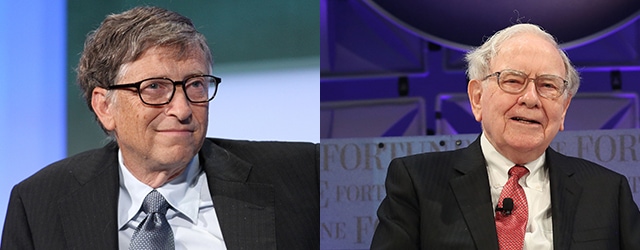The world's billionaires are getting younger and more diverse.

Billionaires are not immune from economic headwinds but they are a one-of-a-kind managers who significantly outperform their peers in private and public markets alike, a report by UBS and PwC published on Friday shows.
The Billionaires Effect 2019 says that at the end of 2018 there are 2,101 billionaires down from 2,158 the year before. In the same year, billionaire wealth declined 4.3% year-over-year to $8.5 trillion as the result of the strong U.S. dollar, a less buoyant economic cycle and of the significant decline of equity prices in the last quarter of 2018. Billionairesalso underperformed the MSCI ACWI index last year which fell a smaller 2.4%.
“The billionaire boom of the past five years has now undergone a natural correction,” says Josef Stadler, head of Ultra High Net Worth at UBS global Wealth Management. “It’s clear that billionaire business continues to thrive. Billionaires are creating and steering businesses that consistently outperform equity markets.”
But the correction, the first in the five-year period that the report is compiled by UBS and PwC, was like “a bumpin the road,”according to John Matthews, head of Private Health Management and Ultra High Net Worth at UBS Global Wealth Management said presenting the report at the 38th floor of UBS in New York City. This dip should not blur the vision of what billionaires are able to achieve.
What the report defines the billionaire effect—an ability to outperform the others—has been particularly evident in the period 2013-2018. The aggregate wealth of billionaires ended 2018 over a third (34.5%) or USD 2.2 trillion, higher than five years earlier.
From 2003 to 2018, billionaire-controlled companies listed on the equity market returned 17.8% compared to the 9.1% of the MSCI AC World Index.
“Our analysis confirms that, on average, billionaires’ success does continue—in both public equity market and private markets. In fact, billionaire-controlled businesses outperform by a surprisingly large margin,” says the report.
Three key elements contribute to the success of billionaire investorssays Matthews, suggesting that all investors could learn something out of these behaviors. These investors have a healthy appetite for risk taking and are very pragmatic. They are focused on their business and constantly looking for opportunity.And they are very determined to win. He also adds, mentioning an unnamed client that billionaires “do not think about the next quarter, but about the next 10 years.”
|
Billionaires By Region 2017-2018 |
|---|
| Region | # of Billionaires 2017 | # of Billionaires 2018 | Total Aggregated Wealth* | Avg. Age* | % of Women Billionaires |
|---|---|---|---|---|---|
| APAC | 814 | 754 | 2,491.9 | 62.35 | 8 |
| Greater China | 475 | 436 | 1,387.7 | 58.94 | 8 |
| Oceania | 43 | 36 | 114.4 | 67.78 | 19 |
| Southeast Asia | 296 | 282 | 989.8 | 66.94 | 5 |
| EMEA | 629 | 598 | 2,409.2 | 62.90 | 14 |
| Eastern Europe | 163 | 151 | 543.1 | 56.96 | 5 |
| MENA | 52 | 50 | 162.3 | 66.10 | 6 |
| Western Europe | 414 | 397 | 1,703.8 | 64.79 | 18 |
| Americas | 715 | 749 | 3,635.7 | 66.60 | 13 |
| North America | 631 | 652 | 3,264.1 | 66.50 | 12 |
| Central and South America | 84 | 97 | 371.6 | 67.27 | 13 |
| Total | 2,158 | 2,101 | 8,536.8 | 64.03 | 11 |
| *Figures for 2018 only. Source: The Billionaire Effect 2019, UBS and PwC. | |||||
The 2,101 billionaires in the world at the end of 2018 wereconcentrated mainly in the United States and Asia and were a younger and more diverse group than in previous years. North America—which still counts with the highest amount of amassed wealth of USD 3.26 trillion—bucked the general trend with 33 more billionaires than the year before and a modest increase (0.1%) in wealth.
Billionaires wealth fell mostly in the APAC region, which remains the region with the highest number of billionaires (754 versus 749 in North America) with China most affected, the report says. “Wealth in APAC ended 2018 at USD 2.5 trillion, down $217.6 billion. The net number of billionaires in the region fell by 7.4% or 60 to 754.”
In the U.S., a driving force in billionaire-creation has been the tech industry, which is injecting dynamism across all the economy. “It is no accident that tech stands out as the one industry where billionaire wealth increased in 2018, rising 3.4% to $ 1.3 trillion, mainly in the US.”Ten of the world’s top 20 tech billionaires are from the U.S. and four from China. The others come from Germany, India and Japan; each are home to two of the top 20. Freshly included tech billionaires include China’s Zhang Yiming, the Chinese Internet entrepreneur, who founded the social media group ByteDance. He did not appear in the group five years ago.
Women are increasing in the ranks of billionaires and rising at faster rate than their male counterparts, says Jennifer Gabrielli, Managing Director and Global Chief of Staff at UBS Investment Banking. The number of women billionaires has grown by 46% in five years, from 160 to 233. By comparison male billionaires increased by 39% in the same period. Female billionaires’ assets rose 26% to $871.2 billion. In most cases, four out of 10, self-made female billionaires built businesses in the consumer and retail sectors. The report brings the example of Li Hayan and Shu Ping who became billionaires after the 2018 IPO of the Haidilao hotpot restaurant chain that is expanding outside China. Another relevant example is Russia’s Tatyana Bakalchuck, a former English teacher and a mother of four, who became billionaire while on maternity leave, founding Wildberries which is Russia’s largest online retailer.



